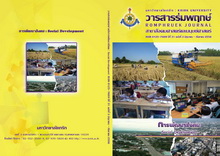พัฒนาการและการเปลี่ยนแปลงรูปแบบการจัดการน้ำเพื่อการเกษตรในพื้นที่ลุ่มน้ำแม่ขานจังหวัดเชียงใหม่
Main Article Content
Abstract
ผลการศึกษาพบว่า เป็นไปตามทฤษฎีการเปลี่ยนแปลงทางสังคมและ ยอมรับแบบจำลองของ Elinor Ostrom (1996) บางส่วนเนื่องจากต้องนำมาประยุกต์ ให้เข้ากับบริบทของพื้นที่ กล่าวคือการจัดการน้ำในพื้นที่เกิดจากการรวมกลุ่ม เกษตรกรแลว้ ร่วมกันพัฒนาระบบเหมืองฝายกับวิธีการบริหารจัดการ ทั้งสองระบบ จะทำงานสัมพันธ์กันจนกลายเป็นแบบแผนในการจัดการน้ำที่มีพัฒนาการ และการ เปลี่ยนแปลงรูปแบบมาถึงปัจจุบันโดยลำดับดังนี้ 1) รูปแบบเหมืองฝายครัวเรือน 2) แก่เหมืองหรือแก่ฝาย 3) องค์กรเหมืองฝาย 4) สหกรณ์ผู้ใช้น้ำ 5) สมาคมผู้ใช้น้ำและ 6) เครือข่ายผู้ใช้น้ำ จากการเปลี่ยนแปลงรูปแบบการจัดการน้ำดังกล่าวเป็น ผลมาจากการเปลี่ยนแปลง 2 ปัจจัยคือ 1) ปัจจัยภายในที่เป็นโครงสร้างหลักของ แต่ละรูปแบบประกอบด้วย 5 ด้านคือ แหล่งน้ำ ระบบส่งน้ำ ผู้ใช้น้ำ กฎกติกา และ ระบบกำกับ 2) ปัจจัยภายนอกประกอบด้วย 6 ด้านคือ ระบบนิเวศแหล่งน้ำ สังคม นิเวศ เศรษฐกิจ นโยบายของรัฐ การใช้ประโยชน์ที่ดิน และลักษณะภูมิประเทศ ส่งผลให้รูปแบบการจัดการน้ำต้องปรับตวั ให้ทนั กบั การเปลยี่ นแปลงเพื่อการคงอยู่ ของสถาบันจัดการน้ำเพื่อการเกษตรในพื้นที่ต่อไป
Evolution and Changing Pattern of Water Resources Management for Agriculture in Mae-Khan Watershed Chiangmai Province
The study entitled “Evolution and Changing of Patterns of Water Resources Management for Agriculture in Mae Khan Watershed in Chiangmai Province” was conducted by employing the Social Change theory and the models of Elinor Ostrom (1996) as a framework of this research. The research methodology included studying the background of each water user group, conducting a site-survey, participating in activities and staying in the community to conduct an observation as well as developing a questionnaire, and conducting in-depth interviews with the groups of leaders, water users, and experts on community water management. The objectives of this research study were to examine the patterns of water management for agriculture, to study structures and scheme of water management for agriculture as well as to investigate the development and changes of patterns of water management for agriculture in Mae Khan Watershed area in Chiangmai province.
The results from the study showed that the development and the patterns of water management for agriculture in the aforementioned area were in accordance with the Social Change theory and the models of Elinor Ostrom (1996) were accepted partially because the theory and the models were taken and applied to be in line with the context of the area. In other words, the water management in the area was formed from the groups of agriculturists. The agriculturists, then, joined hands to develop a local irrigation system and management methods. Both systems worked coordinately and became the scheme of water management which has its development and changes on its patterns from the past up to the present time respectively as follows : 1) a pattern of household irrigation, 2) chief or head of irrigation, 3) irrigation organization, 4) water user cooperative, 5) water user association, and 6) water user network. The changes of the aforementioned water management’s patterns have arisen from the changes of the 2 main factors: 1) the internal factor which was the main structure of each pattern which comprised of 5 aspects: water resources, water delivery system, water users, rules and regulations, and regulatory system, and 2) the external factor which consisted of 6 aspects : water resource ecological system, social ecology, economy, government’s policies, land utilization, and topography. As a result, the patterns of the water management have to be adjusted to keep up with the changes for the existence of the institute of water management for agriculture in the area.
Article Details
Every article published in the Romphruek Journal of the Humanities and Social Sciences is the opinion and point of view of the authors. Thery're not the viewpoint of Krirk University or the editored department. Any part or all of the articles for pablication must be clearly cited.

